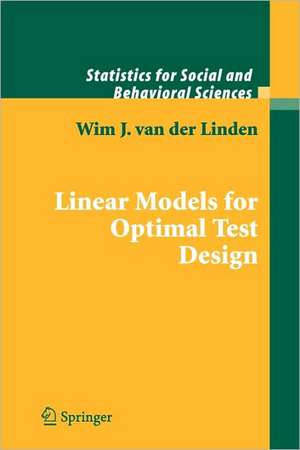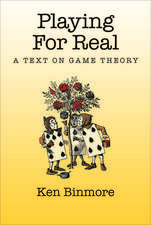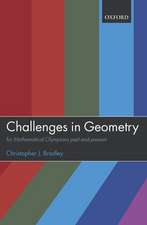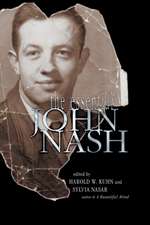Linear Models for Optimal Test Design: Statistics for Social and Behavioral Sciences
Autor Wim J. van der Lindenen Limba Engleză Paperback – 29 noi 2010
| Toate formatele și edițiile | Preț | Express |
|---|---|---|
| Paperback (1) | 896.70 lei 6-8 săpt. | |
| Springer – 29 noi 2010 | 896.70 lei 6-8 săpt. | |
| Hardback (1) | 651.84 lei 6-8 săpt. | |
| Springer – 9 aug 2005 | 651.84 lei 6-8 săpt. |
Din seria Statistics for Social and Behavioral Sciences
-
 Preț: 361.84 lei
Preț: 361.84 lei - 18%
 Preț: 884.35 lei
Preț: 884.35 lei - 20%
 Preț: 696.32 lei
Preț: 696.32 lei - 15%
 Preț: 586.38 lei
Preț: 586.38 lei -
 Preț: 393.13 lei
Preț: 393.13 lei - 15%
 Preț: 648.24 lei
Preț: 648.24 lei - 18%
 Preț: 904.11 lei
Preț: 904.11 lei - 18%
 Preț: 811.61 lei
Preț: 811.61 lei - 18%
 Preț: 782.10 lei
Preț: 782.10 lei - 15%
 Preț: 649.54 lei
Preț: 649.54 lei - 23%
 Preț: 788.32 lei
Preț: 788.32 lei -
 Preț: 390.46 lei
Preț: 390.46 lei - 15%
 Preț: 650.04 lei
Preț: 650.04 lei - 18%
 Preț: 806.87 lei
Preț: 806.87 lei - 18%
 Preț: 952.26 lei
Preț: 952.26 lei - 18%
 Preț: 1126.52 lei
Preț: 1126.52 lei - 18%
 Preț: 1005.11 lei
Preț: 1005.11 lei - 18%
 Preț: 1219.94 lei
Preț: 1219.94 lei - 18%
 Preț: 897.65 lei
Preț: 897.65 lei - 15%
 Preț: 588.37 lei
Preț: 588.37 lei - 15%
 Preț: 644.30 lei
Preț: 644.30 lei - 18%
 Preț: 730.97 lei
Preț: 730.97 lei -
 Preț: 381.21 lei
Preț: 381.21 lei - 15%
 Preț: 638.43 lei
Preț: 638.43 lei - 18%
 Preț: 1228.47 lei
Preț: 1228.47 lei -
 Preț: 386.81 lei
Preț: 386.81 lei - 15%
 Preț: 639.73 lei
Preț: 639.73 lei -
 Preț: 381.00 lei
Preț: 381.00 lei - 18%
 Preț: 1223.74 lei
Preț: 1223.74 lei -
 Preț: 385.25 lei
Preț: 385.25 lei - 15%
 Preț: 702.87 lei
Preț: 702.87 lei -
 Preț: 383.33 lei
Preț: 383.33 lei - 18%
 Preț: 1228.47 lei
Preț: 1228.47 lei -
 Preț: 390.25 lei
Preț: 390.25 lei
Preț: 896.70 lei
Preț vechi: 1093.53 lei
-18% Nou
Puncte Express: 1345
Preț estimativ în valută:
171.60€ • 186.34$ • 144.15£
171.60€ • 186.34$ • 144.15£
Carte tipărită la comandă
Livrare economică 22 aprilie-06 mai
Preluare comenzi: 021 569.72.76
Specificații
ISBN-13: 9781441919038
ISBN-10: 1441919031
Pagini: 436
Ilustrații: XXIV, 408 p. 44 illus.
Dimensiuni: 155 x 235 x 23 mm
Greutate: 0.61 kg
Ediția:Softcover reprint of hardcover 1st ed. 2005
Editura: Springer
Colecția Springer
Seria Statistics for Social and Behavioral Sciences
Locul publicării:New York, NY, United States
ISBN-10: 1441919031
Pagini: 436
Ilustrații: XXIV, 408 p. 44 illus.
Dimensiuni: 155 x 235 x 23 mm
Greutate: 0.61 kg
Ediția:Softcover reprint of hardcover 1st ed. 2005
Editura: Springer
Colecția Springer
Seria Statistics for Social and Behavioral Sciences
Locul publicării:New York, NY, United States
Public țintă
ResearchCuprins
Brief History of Test Theory and Design.- Formulating Test Specifications.- Modeling Test-Assembly Problems.- Solving Test-Assembly Problems.- Models for Assembling Single Tests.- Models for Assembling Multiple Tests.- Models for Assembling Tests with Item Sets.- Models for Assembling Tests Measuring Multiple Abilities.- Models for Adaptive Test Assembly.- Designing Item Pools for Programs with Fixed Tests.- Designing Item Pools for Programs with Adaptive Tests.- Epilogue.
Recenzii
From the reviews of the first edition:
"ATA and OTD research-as a principal researcher and theorist, mentor, or consultant. Linear Models for Optimal Test Design represents an exceptional c ompendium of measurement literature that concisely yet thoroughly documents the expansive range of van der Linden's expertise i n ATA and OTD. This book can serve as a graduate-level textbook or as a technical handbook for researchers and practitioners. It certainly deserves a prominent spot on the book shelves of all measurement professionals interested in test design, test delivery models, and test construction. … To summarize, I found Linear Models for Optimal Test Design to be highly readable. More importantly, the book captures both the breadth and depth of 20 years of research on OTD and ATA technologies. There is no other comparable text on these topics, and I believe that van der Linden's book will remain a key resource (handbook and textbook) for many years to come." (Richard M. Luecht, Applied Psychologic Measurement, Vol. 33, Number 3, May 2009)
"‘Test’ in this book refers to educational and psychological testing, a field which has advanced dramatically in recent decades. … The technical level is kept to a minimum, using little beyond ‘high school algebra’ and linear programming. … I would like to think that this superb comprehensive synthesis of the field by one of its leading proponents will serve to broaden awareness of what can nowadays be achieved using such tools." (D.J. Hand, Short Book Reviews, Vol. 26 (1), 2006)
"...Linear Models for Optimal Test Design is a succinctly written and comprehensive book on optimal test assembly that can serve as a reference book and even as a textbook for courses on test construction. It is a book taht focuses on the author's area of research, yet treats the contributions of others. The result is one of the most useful textbooks available in thefield of educational testing fairly." (Jeffery Douglas for the Journal of the American Statistical Assocation, December 2006)
"This book begins with a reflection on the history of test design – the core activity of all educational and psychological testing. It then presents a standard language for modeling test design problems … . This book … has been written to be a helpful resource on the desk of any test specialist. … This book is intended for graduate students, researchers, test specialists, and especially for anyone seriously interested in the psychometric methods field." (Yuehua Wu, Zentralblatt MATH, Vol. 1084, 2006)
"Test design is the main activity of all educational and psychological testing. The book by van der Linden discusses the various aspects, logistics, problems and solutions of test designs. … The book has potential as a good reference book and good guide to the researchers in this area. Exercises are provided in every chapter. … The reader of this well written book does not need much mathematical or statistical background, and hence it is reachable to a wider audience." (Atanu Biswas, Sankhya: The Indian Journal of Statistics, Vol. 68 (1), 2006)
"This excellent, comprehensive book on test theory and the automatic design of standardized tests is the latest in Springer’s series under the heading Statistics for Social and Behavioral Sciences. … Psychometricians and other test construction specialists will find this book not only valuable but unique in many aspects. I consider the book to be an important document on the bookshelves of these professionals. I also consider it to be a necessary text that should be in every university or department library … ." (Peter Merenda, PsycCRITIQUES, Vol. 51 (7), 2006)
"As a researcher and teacher in the field for 20 years, I would consider this book one of the most inspirational books in measurement and testing since Lord andNovick published theire's in 1968. Definitely, it will become a helpful reference on the desks of many teachers, test specialists, as well as graduate students." (Hua-Hua Chang, Psychometirka, Vol. 72, No. 2, June 2007)
"ATA and OTD research-as a principal researcher and theorist, mentor, or consultant. Linear Models for Optimal Test Design represents an exceptional c ompendium of measurement literature that concisely yet thoroughly documents the expansive range of van der Linden's expertise i n ATA and OTD. This book can serve as a graduate-level textbook or as a technical handbook for researchers and practitioners. It certainly deserves a prominent spot on the book shelves of all measurement professionals interested in test design, test delivery models, and test construction. … To summarize, I found Linear Models for Optimal Test Design to be highly readable. More importantly, the book captures both the breadth and depth of 20 years of research on OTD and ATA technologies. There is no other comparable text on these topics, and I believe that van der Linden's book will remain a key resource (handbook and textbook) for many years to come." (Richard M. Luecht, Applied Psychologic Measurement, Vol. 33, Number 3, May 2009)
"‘Test’ in this book refers to educational and psychological testing, a field which has advanced dramatically in recent decades. … The technical level is kept to a minimum, using little beyond ‘high school algebra’ and linear programming. … I would like to think that this superb comprehensive synthesis of the field by one of its leading proponents will serve to broaden awareness of what can nowadays be achieved using such tools." (D.J. Hand, Short Book Reviews, Vol. 26 (1), 2006)
"...Linear Models for Optimal Test Design is a succinctly written and comprehensive book on optimal test assembly that can serve as a reference book and even as a textbook for courses on test construction. It is a book taht focuses on the author's area of research, yet treats the contributions of others. The result is one of the most useful textbooks available in thefield of educational testing fairly." (Jeffery Douglas for the Journal of the American Statistical Assocation, December 2006)
"This book begins with a reflection on the history of test design – the core activity of all educational and psychological testing. It then presents a standard language for modeling test design problems … . This book … has been written to be a helpful resource on the desk of any test specialist. … This book is intended for graduate students, researchers, test specialists, and especially for anyone seriously interested in the psychometric methods field." (Yuehua Wu, Zentralblatt MATH, Vol. 1084, 2006)
"Test design is the main activity of all educational and psychological testing. The book by van der Linden discusses the various aspects, logistics, problems and solutions of test designs. … The book has potential as a good reference book and good guide to the researchers in this area. Exercises are provided in every chapter. … The reader of this well written book does not need much mathematical or statistical background, and hence it is reachable to a wider audience." (Atanu Biswas, Sankhya: The Indian Journal of Statistics, Vol. 68 (1), 2006)
"This excellent, comprehensive book on test theory and the automatic design of standardized tests is the latest in Springer’s series under the heading Statistics for Social and Behavioral Sciences. … Psychometricians and other test construction specialists will find this book not only valuable but unique in many aspects. I consider the book to be an important document on the bookshelves of these professionals. I also consider it to be a necessary text that should be in every university or department library … ." (Peter Merenda, PsycCRITIQUES, Vol. 51 (7), 2006)
"As a researcher and teacher in the field for 20 years, I would consider this book one of the most inspirational books in measurement and testing since Lord andNovick published theire's in 1968. Definitely, it will become a helpful reference on the desks of many teachers, test specialists, as well as graduate students." (Hua-Hua Chang, Psychometirka, Vol. 72, No. 2, June 2007)
Textul de pe ultima copertă
This book begins with a reflection on the history of test design--the core activity of all educational and psychological testing. It then presents a standard language for modeling test design problems as instances of multi-objective constrained optimization. The main portion of the book discusses test design models for a large variety of problems from the daily practice of testing, and illustrates their use with the help of numerous empirical examples. The presentation includes models for the assembly of tests to an absolute or relative target for their information functions, classical test assembly, test equating problems, item matching, test splitting, simultaneous assembly of multiple tests, tests with item sets, multidimensional tests, and adaptive test assembly. Two separate chapters are devoted to the questions of how to design item banks for optimal support of programs with fixed and adaptive tests. Linear Models for Optimal Test Design, which does not require any specific mathematical background, has been written to be a helpful resource on the desk of any test specialist.
Wim J. van der Linden is Professor of Measurement and Data Analysis, University of Twente, The Netherlands. His specialization is psychometric theory and methods, and he has been an active researcher of item response theory throughout his career. His current research is on test design, adaptive testing, test equating, and response-time modeling. Professor van der Linden is a past president of the Psychometric Society and a recipient of the NCME lifetime achievement award for his work on educational measurement.
Wim J. van der Linden is Professor of Measurement and Data Analysis, University of Twente, The Netherlands. His specialization is psychometric theory and methods, and he has been an active researcher of item response theory throughout his career. His current research is on test design, adaptive testing, test equating, and response-time modeling. Professor van der Linden is a past president of the Psychometric Society and a recipient of the NCME lifetime achievement award for his work on educational measurement.
Caracteristici
Can serve as a handbook for new developments to test specialists working at testing agencies as well as a text for students in classes on test theory, test construction, or applied statistics Includes supplementary material: sn.pub/extras

















